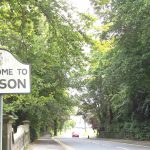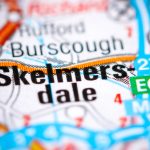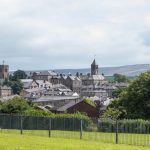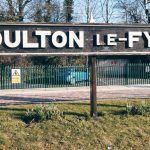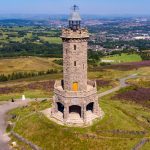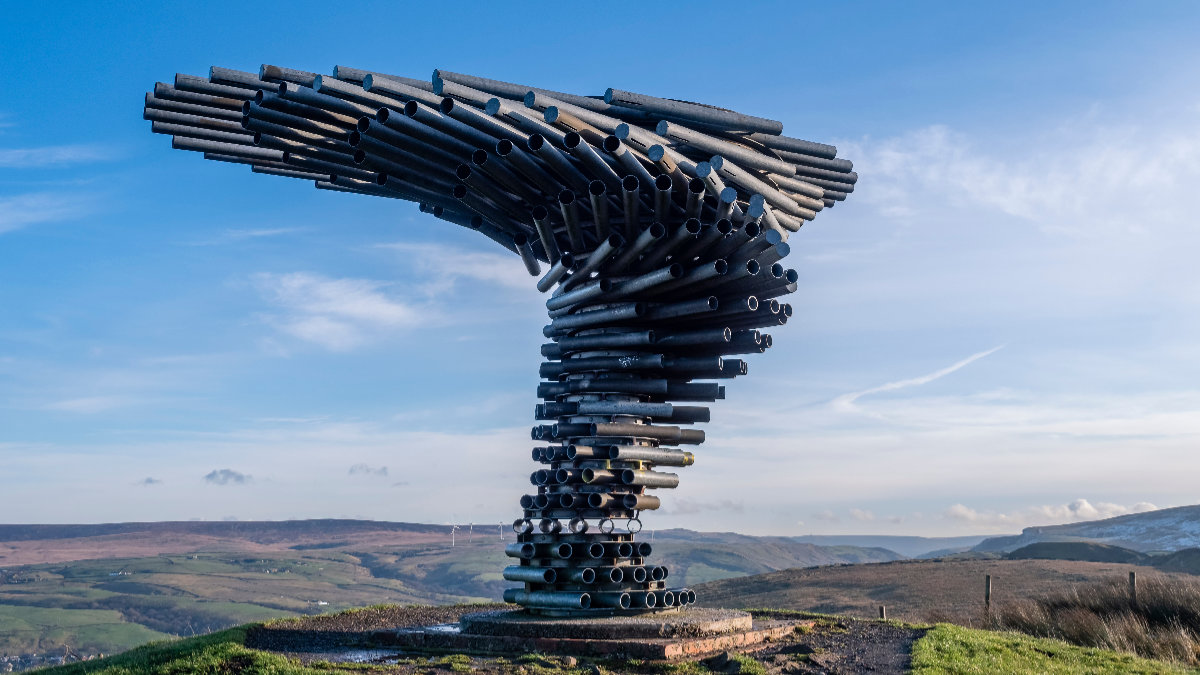
The Lancashire town of Burnley has a long and illustrious history that dates all the way back to mediaeval times. It is situated between the River Calder and the Brun, between Padiham and Accrington, and near the Pendle Forest. This ancient Lancashire town has a population of just over 70,000 people and lies about 20 miles north of Manchester.
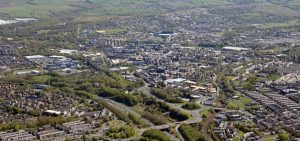
As you can see Burnley is a surprisingly green place – not like its industrial town image.
Image: Neil Mitchell/Shutterstiock.com
As ever, we are here to take a five-minute tour of the town courtesy of Five Minutes Spare. What is there to do in Burnley, does it have any tourist attractions, and what goes on there when the sun goes down? Let’s take a peek and find out…
A Bit of Old Burnley
It is thought that the name Burnley was derived is an adaptation of the old English Brun Lea. This would have referred to the medal by the river Brun. Early records have the settlement as originally been called Bornley, or other variants of the names.
Archaeologists have found stone age circles, hill forts, and even flint tools. This leads us to believe that Burnley was a town long before the dark ages. Castercliff, the Iron Age mud fort nearby, has been dated to 600 BC. There have been a few Roman coins found in the area although there hasn’t been any evidence yet discovered of a Roman fort or settlement. An old Roman road that runs through the centre of town, which makes sense due to strategic positioning between the two rivers.
It is thought that the angles settled the area by the early seventh century, although the Romans would have already left in about 40 A.D. The next official reference to Burnley in the history books was in 1122. This 12th-century document saw a charter granted to the church of Burnley from Pontefract Abbey. This charter would have given the right for the church to have paved the streets, organised cleaning, and perhaps even to have made progress with the Pete water supply.
The Church In Charge
When the church was running the town, it would have fallen into the hundreds of Blackburn Shire as part of the kingdom of Northumbria. It would have had its own market, and people would have come from all over to trade their goods. Cloth grew in importance here as of 1296 when a second mill was added, and the manor was built. The market cross is the only part of those early days which still remains. This cross was built in 1295.
By the 16th century, it is estimated that there were little more than a thousand people living in Burnley, with St Peter’s church being the star attraction. If Gawthorpe Hall and Towneley Hall were added around this time. The church was refurbished in 1532 with the grammar school being added in 1559. The old grammar school is where you will find what remains of the former market cross. During this period of a few hundred years, Burnley developed into our well-known market town in the area and even managed to gain a reputation as housing some of the finest weavers in the region.
For the next 200 or 300 years Burnley developed at a slow pace. It did not suffer as much as some places when Henry VIII decided to revoke the authority of the monasteries since it already centred around the church. That didn’t make it safe, but a good shelter from some of the worst of that particular Kings temper.
The only other thing we want to point out about the early days of Burnley is that it didn’t stay small for long. The industrial revolution swept through this area dragging the town with it, kicking, and screaming the whole way.
Fun Facts About Burnley!
This makes for a natural stopping point; we can take a breather from the history and start talking about fun facts from Burnley.
Here at five minute spare, we like to dig out all the best gossip about the places that we reviewed. So before we get onto the rest of the history, and before we get lost in all the attractions that the time provides, let’s take a quick glance over some of the funniest things we found out about Burnley during our research.
Without further ado here are the fun facts about Burnley we have all been waiting for:
- The River Brun, which the town grew up around, is the shortest river in Britain.
- Brun is actually old English for Brown and has nothing to do with the Scottish burn, as you might think.
- Back in the Industrial Revolution Burnley was recognised as having one of the best mill engines in the world. Cast and wrought iron were made here on machines fuelled with coal mined in England.
- One in three of all bottles of Benedictine are sold in Burnley, the majority of which go through the local minor social club.
- Burnley football club had a30 match unbeaten run in 1921 and this record was unbroken until the 2004/2005 season.
There are more details than this, but most of them revolve around either the football club or the fact that nothing much interesting really ever happens in Burnley. Let’s not focus on that fact and move swiftly on back to the history. We left off at the start of the Industrial Revolution so let’s pick up at the beginning of the 19th century.
Burnley’s Industrial Heritage
Burnley was already a thriving wool fulling town. Wool would have been brought in from the surrounding countryside, dyed, treated, and fulled here, to make it thicker, and to make it go farther. Some of the biggest mills and the earliest factories in Burnley, were set upon the banks of the River Calder at the confluence with the Brun. In 1754 the first turnpike road ran through Burnley, linking the town to Blackburn and other towns and villages, and bringing in yet more work for locals.
Around 1800 it was becoming more acceptable to use waterpower to drive the spinning machines within the mills, which ultimately led to the poor working conditions we associate with the Industrial Revolution. Children, with their tiny fingers and smaller hands, were able to reach into tight spaces and thread the machines, so they were often employed within the mills. It was the linking of the road which solidified the Brun Lea area, ultimately defining it as a town.
Coal On The Rise
By the 1800s there were already a number of coal pits within the town centre itself. Coalmining was huge, with the Burnley coalfield bringing in thousands of tonnes of coal a year. The Industrial Revolution saw a huge demand for coal and Burnley was sitting on top of a whole vein of it. The Leeds and Liverpool Canal joined the town in 1796 specifically for the transportation of goods (such as coal) up and down the river.
In 1820 a barracks was added, and the army moved in. Then, in 1824, the town’s first and only bank had to close down. This unexpected closure forced many businesses in town to die and was closely followed by a drought that ended up causing serious problems for the rest of the businesses. In 1825 there was a financial crisis, partially fuelled by this closure, in 1824. However, the good folks of Burnley couldn’t be kept down for long.
In 1830 there was grand total of 32 steam engines being used by the cotton mills all around town. The Irish potato famine circa 1845, saw a huge migration of Irish people to the town. To the point where Burnley has a part that some people occasionally referred to as the Irish Park. By 1848 the railway arrived in town causing a sudden population which, when combined with the recently established Irish families, swelled up to about 21,000 people.
Loom Town
The Lancashire Loom was developed amidst the heart of all this, roundabout 1842. It was created by two men from Burnley, named James Bullough and William Kenworthy. The Lancashire loom would be used throughout the Lancashire area as the name suggests, from 1842 right up until the textile industry started to drop off roundabout 1950. This all allowed them to partially automate the weaving process, thereby doubling the amount of fabric made and ensuring better profits.
Funnily enough, ancestry.uk records Burnley as a habitational family name. The reason this is strange is that this was a tactic that the Vikings would employ when they decided to settle in a new area. Many family names occurred around about the 10th century, purely because the Vikings had landed. Coincidentally, that 10th-century mark happens to be around about the same time as Burnley was created. Obviously, Burnley is on the coast, but it’s still a bit of a coincidence. Could it be the Burnley inhabitants are descended from Vikings? You never know…
From 1861 to 1865 the American Civil War was the cause of a widespread cotton fa
Oh No No Cotton
mine. The farmers on the plantations in America commonly used slaves to harvest the cotton but could no longer do this anymore, the cotton went unpicked, causing Burnley to have little to weave with. Wool would have become popular again for a couple of years before the recovery kicked in. When cotton was once again available in 1866 Burnley quickly found itself to be the centre of the cotton cloth manufacturing world. The 32 steam engines powering the cotton mills, coupled with the Lancashire loom, made them one of the biggest producers of cotton cloth in the entire world at that time.
Burnley is also famous for the Burnley Building Society, which was set up around the same time and had achieved international notoriety by the start of the 20th century. Another interesting point came in the 1880s when the town switched focusses slightly. While cotton was still produced here in large volumes, they were selling more looms than anywhere else in Britain. In 1911 the more than 100,000 powered looms in Burnley.
That brings is up roughly to the start of the First World War. Let’s take a momentary break from the history and focus on famous faces.
Famous People from Burnley
Burnley has spawned a few famous faces in its time, although you would be forgiven if it doesn’t know that. Seemingly sweet and serene Burnley is the home to a fair few famous people. Here some of Five Minutes Spare’s favourites:
- Sir Ian McKellen thespian extraordinaire, X-Men’s Magnito and of course Gandalf in Lord of The Rings. It would take us all day to go through his Bio!
- Fabian Coulthard, the race car driver, is a Burnley man.
- Paul Abbott, the producer, is from these parts.
- The artist Pamela Drew lived here.
- Natalie Gumede from Corrie is from Burnley really.
- Delamitri and All About Eve drummer Mark Price lives in Burnley, too.
There are about a hundred more. You can view a fuller list on Wikipedia but even that isn’t exhaustive. Needless to say, Burnley has enough famous faces to make it of interest to the paparazzi once in a while. No speeding cars… too soon?
Burnley During the War
Burnley was one of the towns of England which gave the most during the First World War. A reported 4000 young men, about 15% of all working-age men in Burnley, signed up and went off to war. They were never seen again. Mistakes were made during the Great War. The British government thought that more young men would volunteer if they could do so with their friends. The buddy regiment was born.
This allowed young men to sign up with their friends and be guaranteed to be sent to the same regiment. Where this meant that you could go to war with the support of those that you already cared about, it also meant that vast swathes of youngsters from the same area were killed. A whole generation of young men were wiped out in Burnley. And by the Second World War, things hadn’t much improved.
WWII
During the Second World War it was the bombs that caught the attention of the masses. Around 16 people (that we know about) were killed in Burnley during the Second World War. Again men were sent away to die, but at least this time men from the same street were sent to different regiments. The Lancashire Telegraph has an interesting article that explores World War II bomb sites in and around Burnley. There is also a local walk that will allow you to view where the bombs were dropped. Since the world wars, Burnley has become noted for a little more than cotton. Just after World War II, the theatre in Burnley was considered to be one of the best in Britain. In 1955 the Queen and Prince Philip came to town and visited a valve factory, which is just as weird as it sounds.
The 1960s
The Queen came back again in 1961 to mark the hundredth anniversary of Burnley as a borough. The ghettos were demolished, and council houses were built. Hotels were added, a bus station was built, office blocks went up, and the old cattle market and market Hall were demolished. In 1980 Burnley was connected to the motorway, they had to demolish the old barracks in order to do this. In the 90s there were some riots in the council estates, presumably because of a period of austerity. In 2001 there were more riots, and some of these were racially focused in Burnley. We like to think that we’ve come a long way since then.
Since the millennium, Burnley has gone from strength to strength. A number of retail establishments and eateries have opened up, along with the odd attraction. This is a historic town with fantastic future potential, that celebrates and commemorates its past. To this day, you will see 2000 names engraved on a carousel of displays within the town hall. These 2000 names were created at the end of the First World War, in order to celebrate some of the lives that were lost. It’s a thoughtful place. Really, you should go there sometime.
Getting Here
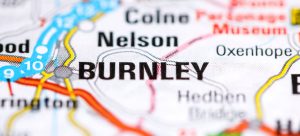
Image: SevenMaps/Shutterstock.com
Things to do in Burnley
This section is where we examine the attractions found in detail, so you can plan your next staycation itinerary.
Historic Sights and Landmarks
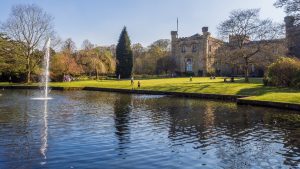
Image: Sue Burton Photography
Towneley Hall is one of the favourite historic sites in Burnley. This estate combines a stately home dating back to the 16th-century, with elegant gardens, a beautiful duck filled pond, and an old school Victorian kitchen. There is also an art gallery on the site, so you can browse some famous works. If you are in Burnley for Christmas, definitely go here.
The biggest landmark in the area is the Singing Ringing Tree- Panopticon, which is positioned on Crown Point – a local viewpoint – is a musical sculpture. This makes it a wonderful, thrilling piece of art for young kids, who just can’t believe their ears. It’s well worth the walk uphill.
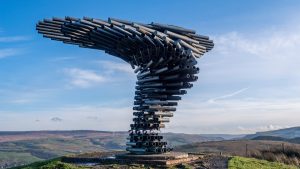
Image: Pete Stuart/Shutterstock.com
No visit is complete without a stroll along the canal!
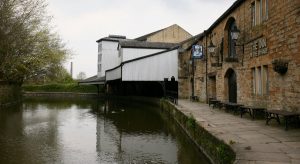
The picturesque Burnley Wharf
Image: Keith Heaton/Shutterstock.com
Museums in Burnley
The Queen Street Mill Textile Museum is one of the best museums in town. It will teach you all about the importance of that Lancashire Loom that we mentioned earlier. It is often filled with educational groups there to learn about their hometown, usually sent from a school.
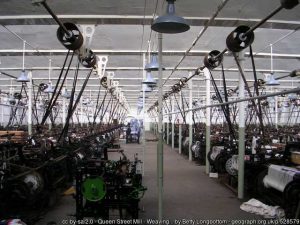
The Museum has some working looms on display – a reminder of the towns once-proud textiles heritage.
Check out the Weaver’s Triangle visitors centre for another historic attraction-come-museum in the area. This contains the wharf master’s house, where the old cotton weavers would have paid a toll to have their wares sent on towards Leeds to be sold. Pretty cool.
Sport and Teams
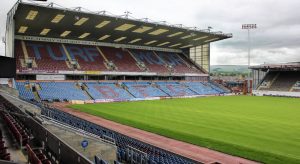
Image:jgolby/Shutterstock.com
Burnley football club we already mentioned that Burnley FC managed that winning streak back in 1920. So Burnley are a historic team. At the time of writing, Burnley FC play in the Premier League and were playing the likes of Manchester City, Leicester City, and Southampton. You can visit Burnley FC at the Turf Moor stadium, another local landmark.
Burnley also has its own rugby club if that is your game, which is known as Burnley RUFC. When in town, you also have the option of going to Burnley Golf club, Towneley Golf club, or using the Brunshaw Golf Course. Don’t forget that you can get everything you need for all your sport and recreation activities, from the prairie sports village. They also have mini golf and their own restaurant.
Outdoors and Recreation
When in town and looking for something to do with children, why not take them for an afternoon at the Cliviger Fish Ponds. You might want to try and keep the kids quiet however, since this place is a favourite with local angling societies.
Thompson Park is another favourite spot for families to picnic, enjoy some swings, and generally have a good time. If you happen upon Thompson Park on a particularly sunny day, you will find lots of sunbathing locals. They don’t mind if you join in.
Finally, by no means exhaustively, we would like to recommend a day spent at Shores Hey Farm. This is a petting zoo come farmhouse, with rooms for eating, plenty of horses, and room to stay over if you fancy. Kids love it, enough said.
Other Notable Attractions
Burnley is a busy place, with so many attractions that we couldn’t possibly list them all in one article. But we did the best we could. So here are a few more notable attractions in Burnley that you should visit if you’re in the area:
- Eat out in style, with a view of the water, at the Reedley Marina Bistro bar.
- Adults will love Muirhouse’s Brewery, where they can take a tour and drink all the drinks.
- There is a second stately home in the area, known as Gawthorpe Hall.
- The religious will enjoy a Sunday at St Peter’s Church.
- As for shopping and retail, the Burnley markets and the charter walk shopping centre, are the two places to be.
There’s a ton of more fun things to do in Burnley we just don’t have space to cover them all. Remember you can head on over to our forum if you can think of a few more.
Five More Minutes…
If you are looking for the perfect place to go on holiday this year within the UK, you will find plenty more destinations to choose from, over at Five Minutes Spare HQ. All
